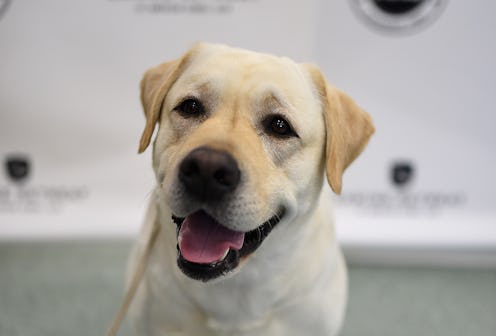Life
Why Your Dog’s Puppy Face Melts Your Heart, According To Researchers

Anybody who's ever been a victim of their dog's puppy eyes — the widened, infantile stare that makes any dog look like a helpless baby, and forces their human target to reach for the treats — will vouch for their power. And science has determined that the puppy dog eye is an evolved feature of the modern, domesticated dog. It turns out that there's a particular muscular system in dogs' faces responsible for those raised eyebrows and adorable expressions, and a study just published in PNAS has determined that those muscles evolved after dogs began to be domesticated — and may have developed to help them bond with humans.
Dogs were first domesticated from wild wolves as long as 40,000 years ago, though scientists are divided about the specific timing and where the wolves themselves came from. The new study was a partnership between dog cognition experts and anatomists, and looked at dog eyebrow muscles — specifically the levator anguli oculi medialis, which is the muscle responsible for lifting your dog's inner eyebrow and forming those huge, irresistible expressions of love and appeal. The study found that dogs have the eyebrow muscle, but wolves don't; there's no chance of a wolf giving you that puppy-dog look, because they lack the facial muscles.
"Behavioral data show that dogs also produce the eyebrow movement significantly more often and with higher intensity than wolves do, with highest-intensity movements produced exclusively by dogs," the study says. In other words, dogs are seriously likely to move their eyebrows around, while wolves don't — and that has big implications for dog-human bonding.
"When my dog does this to me, I drop what I'm doing, and I try to figure out, does she want a biscuit? Does she want a toy? Does she need to go outside? So it seems to be a mechanism to get people to pay attention to them," Professor Anne Burrows, PhD, of Duquesne University, one of the authors on the study, tells Bustle. "When humans look at dog faces and respond positively, we know now that one of the things they're responding to is this change in eyebrow movement."
This distinction between dog and wolf eyebrow muscles, Professor Burrows tells Bustle, implies that they developed in dogs after domestication began. It's likely that humans deliberately bred dogs over hundreds of generations to have those puppy dog eyes, simply because we like the feature so much. "We know all sorts of things about how dogs and wolves differ, but we still have questions," says Professor Burrows. "What were the factors that led to dog domestication? What behaviors and anatomies did ancient humans select when they were domesticating dogs?" It appears that expressive eyebrows are one of the answers.
There are a few hypotheses as to why humans love puppy dog eyes. Humans respond very strongly to faces that look baby-like, in both children and other animals. "Human infants make a similar movement with their eyes," says Professor Burrows. "It makes their eyes look a little bit larger, it suggests that maybe they're sad or worried about something. Those seem to be responses that humans feel when they look at a dog making this face as well." In 1943, ethologist Konrad Lorenz came up with the "baby schema," or the arrangement of features on a baby's face that are appealing to adults, which include huge eyes and a large head. When we see a "baby schema," whether it's human or not, we feel an urge to nurture and protect.
If you think your dog's deliberately trying to make you feel bad with those big eyes, however, you might not be precisely correct. "There is no evidence at the moment to suggest that dogs are raising their eyebrows intentionally, that is with the understanding that it might manipulate humans," Dr. Juliane Kaminski, PhD, of the University of Portsmouth, the lead author of the study, tells Bustle. "What we do know is that it seems to be a voluntary movement. Dogs move their eyebrows more when someone is looking at them suggesting that it is, to some extent, under their voluntary control." She adds that there's "no research at the moment" to pinpoint whether dogs give more eyebrow movements (and puppy dog expressions) to their owners versus strangers.
Along with eyebrow muscles, it's also possible that humans selectively bred some dogs to look as if they had physical eyebrows — like the markings on the faces of Labradors and German Shepherd breeds. "Dogs have a very wide range of facial patterns in their fur; we're interested in finding out why," Professor Burrows tells Bustle. "Why were humans selecting for those different color patterns? Does that draw people's attention even further to the eye region?" Further studies of dog facial fur will be needed to answer these questions, but the history of dog-human relationships has clearly changed both species — for the better.
Dogs have evolved their beautiful expressions over centuries with humans, but it's not clear whether they're aware of the effects of their mournful, wide eyes, or are using them to get just one more treat. Let's face it: you probably just want an excuse to give them five. They deserve it.